Rock ptarmigan
The rock ptarmigan (Lagopus muta) is a medium-sized gamebird in the grouse family. It is known simply as the ptarmigan in the UK and in Canada, where it is the official bird for the territory of Nunavut,[3] and the official game bird for the province of Newfoundland and Labrador.[4] In Japan, it is known as the raichō (雷鳥), which means "thunder bird". It is the official bird of Gifu, Nagano, and Toyama Prefectures and is a protected species nationwide.
| Rock ptarmigan | |
|---|---|
.jpg) | |
| A pair in spring plumage in Norway | |
| Scientific classification | |
| Kingdom: | Animalia |
| Phylum: | Chordata |
| Class: | Aves |
| Order: | Galliformes |
| Family: | Phasianidae |
| Genus: | Lagopus |
| Species: | L. muta |
| Binomial name | |
| Lagopus muta (Montin, 1776) | |
| Subspecies | |
|
some 20–30, including:
| |
 | |
| Rock Ptarmigan range[2] | |
| Synonyms | |
| |
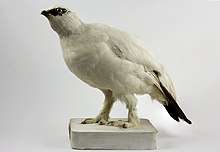
Etymology
The ptarmigan's genus name, Lagopus, is derived from Ancient Greek lagos (λαγώς lagṓs), meaning "hare", + pous (πούς poús), "foot", in reference to the bird's feathered legs.[5]
The species name, muta, comes from New Latin and means "mute", referring to the simple croaking song of the male.[5] It was for a long time misspelt mutus, in the erroneous belief that the ending of Lagopus denotes masculine gender. However, as the Ancient Greek term λαγώπους lagṓpous is of feminine gender, and the species name has to agree with that, the feminine muta is correct.[6]
The word ptarmigan comes from the Scottish Gaelic tàrmachan, literally croaker.[7] The silent initial p was added in 1684 by Robert Sibbald through the influence of Greek, especially pteron (πτερόν pterón), "wing", "feather", or "pinion".[7]
Description
The rock ptarmigan is 34–36 cm (13–14 in) long (tail 8 cm (3.1 in)) with a wingspan of 54–60 cm (21–24 in).[8] It is smaller than the willow ptarmigan by about ten percent.[8] The male's "song" is a loud croaking.
The rock ptarmigan is seasonally camouflaged; its feathers moult from white in winter to brown in spring or summer. The breeding male has greyish upper parts with white wings and under parts. In winter, its plumage becomes completely white except for the black tail. It can be distinguished from the winter willow ptarmigan by habitat—the rock ptarmigan prefers higher elevations and more barren habitat; it is also smaller with a more delicate bill.
Distribution and habitat
The rock ptarmigan is a sedentary species which breeds across arctic and subarctic Eurasia and North America (including Greenland) on rocky mountainsides and tundra. It is widespread in the Arctic Cordillera and is found in isolated populations in the mountains of Norway, Scotland, the Pyrenees, the Alps, Bulgaria, the Urals, the Pamir Mountains, the Altay Mountains, and Japan—where it occurs only in the Japan Alps and on Hakusan mountain.[9] Because of the remote habitat in which it lives, it has only a few predators—such as golden eagles—and it can be surprisingly approachable. It has been introduced to New Zealand, South Georgia, the Kerguelen Islands, and the Crozet Islands.[10]
The small population living on Franz Josef Land in the Russian High Arctic overwinters during the polar night and survives by feeding on rich vegetation on and underneath high cliffs where seabird colonies are located in summer.[11]
During the last ice age, the species was far more widespread in continental Europe.[12]
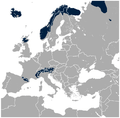
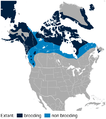 Distribution in North America[2]
Distribution in North America[2]
Ecology
Feeding
The rock ptarmigan feeds primarily on birch and willow buds and catkins when available. It also eats various seeds, leaves, flowers, and berries of other plant species. Insects are eaten by the developing young.
Breeding
Apart from the comb, the male rock ptarmigan has no ornaments or displays that are typical for grouses in temperate regions. Studies on other grouses have shown that much variation in comb size and colour exists between the species,[13] and that the comb is used in courtship display and aggressive interactions between males.[14] Many studies have shown that there is a strong correlation between the comb size and the level of testosterone in males;[15] one report from 1981 showed that the amount of testosterone is correlated to aggressiveness against other males.[16]
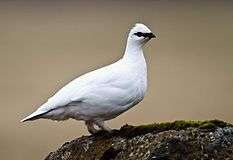 Female Ptarmigan (L. m. islandorum) in winter plumage in Iceland
Female Ptarmigan (L. m. islandorum) in winter plumage in Iceland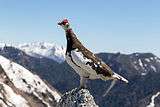 Male Ptarmigan (L. m. japonicum) in summer plumage on Mount Tsubakuro, Japan
Male Ptarmigan (L. m. japonicum) in summer plumage on Mount Tsubakuro, Japan_2.jpg)
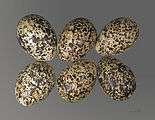 L. muta eggs
L. muta eggs- Ptarmigan chick on Mount Ontake, Japan
The male's comb has been the focus of studies regarding sexual selection. Studies of a population of male rock ptarmigans in Scarpa Lake, Nunavut, have shown that during the first year, mating success among males was influenced by comb size and condition, and bigamous males had larger combs than monogamous males. The correlation to size disappeared after the first year, but the correlation to comb condition remained.[17] This is consistent with another study of the same population of L. muta that showed that mating success overall is correlated to comb condition. Exceptions were first-time breeders, in which the size of the comb influenced mating success.[18]
The rock ptarmigan becomes sexually mature at six months of age and commonly has up to six chicks. Because of this high breeding rate, the size of the population is affected very little by factors such as hunting.
In culture
Rock ptarmigan meat is a popular part of festive meals in Icelandic cuisine. Hunting of rock ptarmigans was banned in Iceland in 2003 and 2004 due to its declining population. Hunting has been allowed again since 2005, but is restricted to selected days, which are revised yearly and all trade of rock ptarmigan is illegal.[19]
In Thomas Bewick's A History of British Birds (1797) the species is named as "White Grouse" with alternatives "White Game, or Ptarmigan". The birds feed, records Bewick, "on the wild productions of the hills, which sometimes give the flesh a bitter, but not unpalatable taste: it is dark coloured, and has somewhat the flavour of the hare."[20]
Provincial bird
The Rock ptarmigan is the official territorial bird of Nunavut, Canada.[21] Its Inuktitut name is ᐊᕐᑭᒡᒋᖅ ᐊᑕᔪᓕᒃ, aqiggiq atajulik.[22] It is the official game bird of Newfoundland and Labrador.
References
- BirdLife International (2016). "Lagopus muta". IUCN Red List of Threatened Species. 2016 (errata version published in 2017): e.T22679464A113623562. doi:10.2305/IUCN.UK.2016-3.RLTS.T22679464A89358137.en.CS1 maint: uses authors parameter (link){{cite iucn}}: error: |doi= / |page= mismatch (help)
- BirdLife International and NatureServe (2014) Bird Species Distribution Maps of the World. 2012. Lagopus muta. In: IUCN 2015. The IUCN Red List of Threatened Species. Version 2015.2. http://www.iucnredlist.org. Downloaded on 08 July 2015.
- Government of Nunavut. "The Rock Ptarmigan (LAGOPUS MUTUS) Official Bird of Nunavut". Retrieved 2010-12-04.
- "The Arms, Seals, and Emblems of Newfoundland and Labrador".
- Jobling, James A (1991). A Dictionary of Scientific Bird Names. OUP. ISBN 978-0-19-854634-4.
- David, Normand & Gosselin, Michel (2002): The grammatical gender of avian genera. Bull. B. O. C. 122(4): 257-282.
- Lockwood, W B (1993). The Oxford Dictionary of British Bird Names. OUP. ISBN 978-0-19-866196-2.
- The Birds of the Western Palearctic [Abridged]. OUP. 1997. ISBN 978-0-19-854099-1.
- Birds in Japan, by Yoshimaro Yamashina, 1961, published by Tokyo News Service
- Long, John L. (1981). Introduced Birds of the World. Agricultural Protection Board of Western Australia, 21-493
- Dinets, V. (2001) Winter ecology of Willow Ptarmigan Lagopus lagopus and Rock Ptarmigan L. mutus at the northern limit of their range. Ornitologia 29: 326-327 (in Russian with English summary).
- Tomek, Teresa & Bocheński, Zygmunt (2005): Weichselian and Holocene bird remains from Komarowa Cave, Central Poland. Acta zoologica cracoviensia 48A(1-2): 43-65. PDF fulltext
- Johnsgard, P. A. (1984), Grouse of the world, Lincoln: University of Nebraska Press, ISBN 978-0-8032-2558-9.
- Hjorth, I. (1970), "Reproductive behaviour in Tetraonidae", Viltrevy, 7: 183–596.
- Stokkan, K. A. (1979a), "Testosterone and daylength-dependent development of comb size and breeding plumage of male willow ptarmigan (Lagopus lagopus lagopus)", The Auk, 96 (1): 106–115, JSTOR 4085405.
- Wattson, A. & Parr, R. (1981), "Hormone implants affecting territory size and aggressive and sexual behaviour in red grouse", Ornis Scandinavica, 12 (1): 55–61, doi:10.2307/3675905, JSTOR 3675905.
- Brodsky, L. M. (1988), "Mating tactics of male rock ptarmigan, Lagopus mutus: a conditional mating strategy", Animal Behaviour, 36 (2): 335–342, doi:10.1016/S0003-3472(88)80003-4.
- Holder, K. & Montgomerie, R. (1993), "Context and consequences of comb displays by male rock ptarmigan", Animal Behaviour, 45 (3): 457–470, doi:10.1006/anbe.1993.1057.
- "Umhverfisráðuneyti" (in Icelandic). Retrieved 30 May 2013.
- Bewick, Thomas; Beilby, Ralph (1797). "White Grouse". A History of British Birds, Volume 1: Land Birds. Beilby and Bewick.
- "The Official Bird of Nunavut | Nunavut Legislative Assembly". assembly.nu.ca. Retrieved 2019-02-22.
- "Anirniliit - those which breathe". www.arctic.uoguelph.ca. Retrieved 2019-02-22.
External links
| Wikimedia Commons has media related to: |
| Wikispecies has information related to Lagopus muta |
- Stamps: Rock Ptarmigan (worldwide); with world RangeMap
- Ptarmigan videos, photos & sounds on the Internet Bird Collection
- Ptarmigan RSPB
- Rock Ptarmigan-Lagopus muta photo gallery VIREO
- Lagopus muta in the Flickr: Field Guide Birds of the World
- "Lagopus muta". Avibase.

- Montin (1776). Phys. Sälsk. Kandl. 1: 155.
